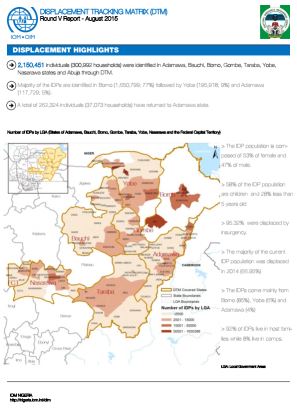-
Countries
-
Data and Analysis
-
Special Focus
-
Crisis Responses
Nigeria — Displacement Report 5 (1 July — 31 August 2015)

Contacter
DTM Nigeria, AllUsersInDTMNigeria@iom.int
Langue
English
Emplacement
Nigeria
Période couverte
Jul 01 2015
Aug 31 2015
Activité
- Mobility Tracking
- Baseline Assessment
2,150,451 IDPs (300,992 households) were identified in Adamawa, Bauchi, Borno, Gombe, Taraba, Yobe, Nasarawa states and Abuja. Borno state (1,650,799 IDPs) has the highest number of IDPs, followed by Yobe (195,918 IDPs) and Adamawa (117,729 IDPs). 262,324 individuals (37,073 households) have returned to Adamawa state. The IDP population is 53% female and 47% male. 58% of the IDP population are children and 28% are less than five years old. 92% of IDPs live in host families while 8% live in camps. The report contains details of location of displacement, demographics, reasons for displacement, duration of displacement, place of origin of IDPs, types of location, data on returnees, registration of IDPs (including information on needs, vulnerability and return intentions). Site assessment information is available for 50 of 59 camps or camp-like sites, and includes demographic data as well sectoral needs, namely shelter, WASH, food and nutrition, health, education, protection, communication and livelihoods. A site assessment in host communities provides brief details of needs for these displaced populations.
